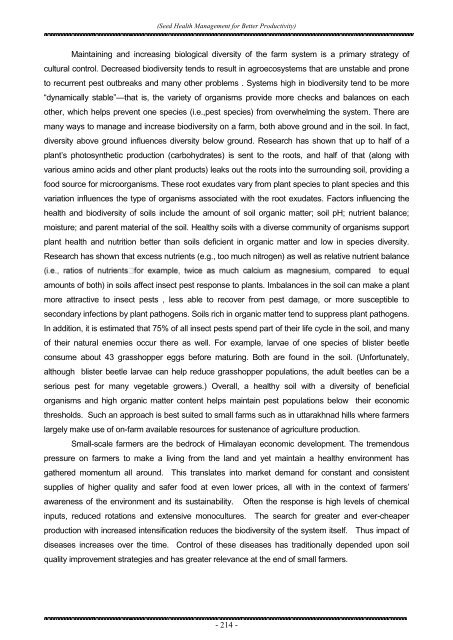Seed Health Management for Better Productivity - Govind Ballabh ...
Seed Health Management for Better Productivity - Govind Ballabh ...
Seed Health Management for Better Productivity - Govind Ballabh ...
Create successful ePaper yourself
Turn your PDF publications into a flip-book with our unique Google optimized e-Paper software.
(<strong>Seed</strong> <strong>Health</strong> <strong>Management</strong> <strong>for</strong> <strong>Better</strong> <strong>Productivity</strong>)Maintaining and increasing biological diversity of the farm system is a primary strategy ofcultural control. Decreased biodiversity tends to result in agroecosystems that are unstable and proneto recurrent pest outbreaks and many other problems . Systems high in biodiversity tend to be more“dynamically stable”—that is, the variety of organisms provide more checks and balances on eachother, which helps prevent one species (i.e.,pest species) from overwhelming the system. There aremany ways to manage and increase biodiversity on a farm, both above ground and in the soil. In fact,diversity above ground influences diversity below ground. Research has shown that up to half of aplant’s photosynthetic production (carbohydrates) is sent to the roots, and half of that (along withvarious amino acids and other plant products) leaks out the roots into the surrounding soil, providing afood source <strong>for</strong> microorganisms. These root exudates vary from plant species to plant species and thisvariation influences the type of organisms associated with the root exudates. Factors influencing thehealth and biodiversity of soils include the amount of soil organic matter; soil pH; nutrient balance;moisture; and parent material of the soil. <strong>Health</strong>y soils with a diverse community of organisms supportplant health and nutrition better than soils deficient in organic matter and low in species diversity.Research has shown that excess nutrients (e.g., too much nitrogen) as well as relative nutrient balanceualamounts of both) in soils affect insect pest response to plants. Imbalances in the soil can make a plantmore attractive to insect pests , less able to recover from pest damage, or more susceptible tosecondary infections by plant pathogens. Soils rich in organic matter tend to suppress plant pathogens.In addition, it is estimated that 75% of all insect pests spend part of their life cycle in the soil, and manyof their natural enemies occur there as well. For example, larvae of one species of blister beetleconsume about 43 grasshopper eggs be<strong>for</strong>e maturing. Both are found in the soil. (Un<strong>for</strong>tunately,although blister beetle larvae can help reduce grasshopper populations, the adult beetles can be aserious pest <strong>for</strong> many vegetable growers.) Overall, a healthy soil with a diversity of beneficialorganisms and high organic matter content helps maintain pest populations below their economicthresholds. Such an approach is best suited to small farms such as in uttarakhnad hills where farmerslargely make use of on-farm available resources <strong>for</strong> sustenance of agriculture production.Small-scale farmers are the bedrock of Himalayan economic development. The tremendouspressure on farmers to make a living from the land and yet maintain a healthy environment hasgathered momentum all around. This translates into market demand <strong>for</strong> constant and consistentsupplies of higher quality and safer food at even lower prices, all with in the context of farmers’awareness of the environment and its sustainability. Often the response is high levels of chemicalinputs, reduced rotations and extensive monocultures. The search <strong>for</strong> greater and ever-cheaperproduction with increased intensification reduces the biodiversity of the system itself. Thus impact ofdiseases increases over the time. Control of these diseases has traditionally depended upon soilquality improvement strategies and has greater relevance at the end of small farmers.- 214 -
















